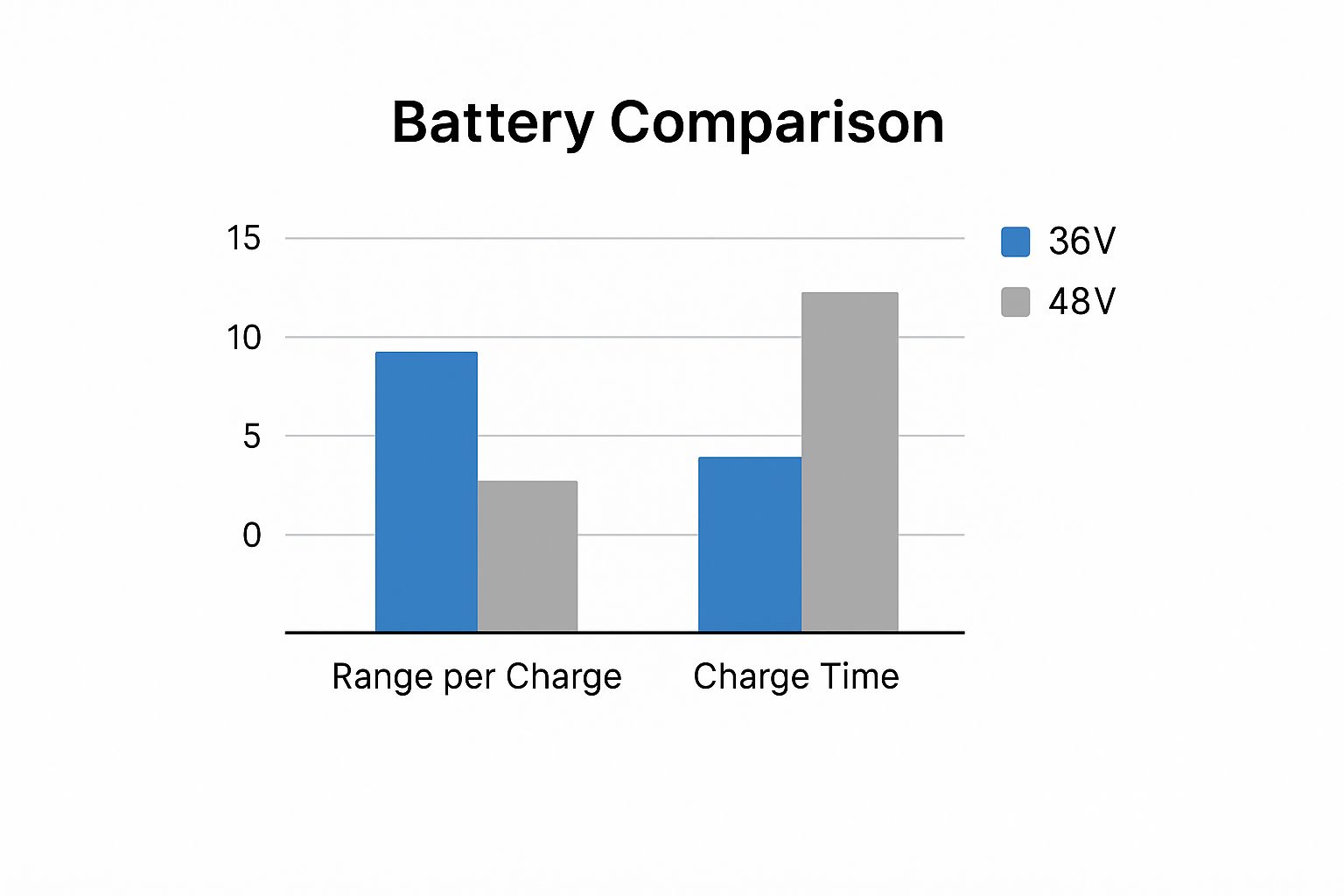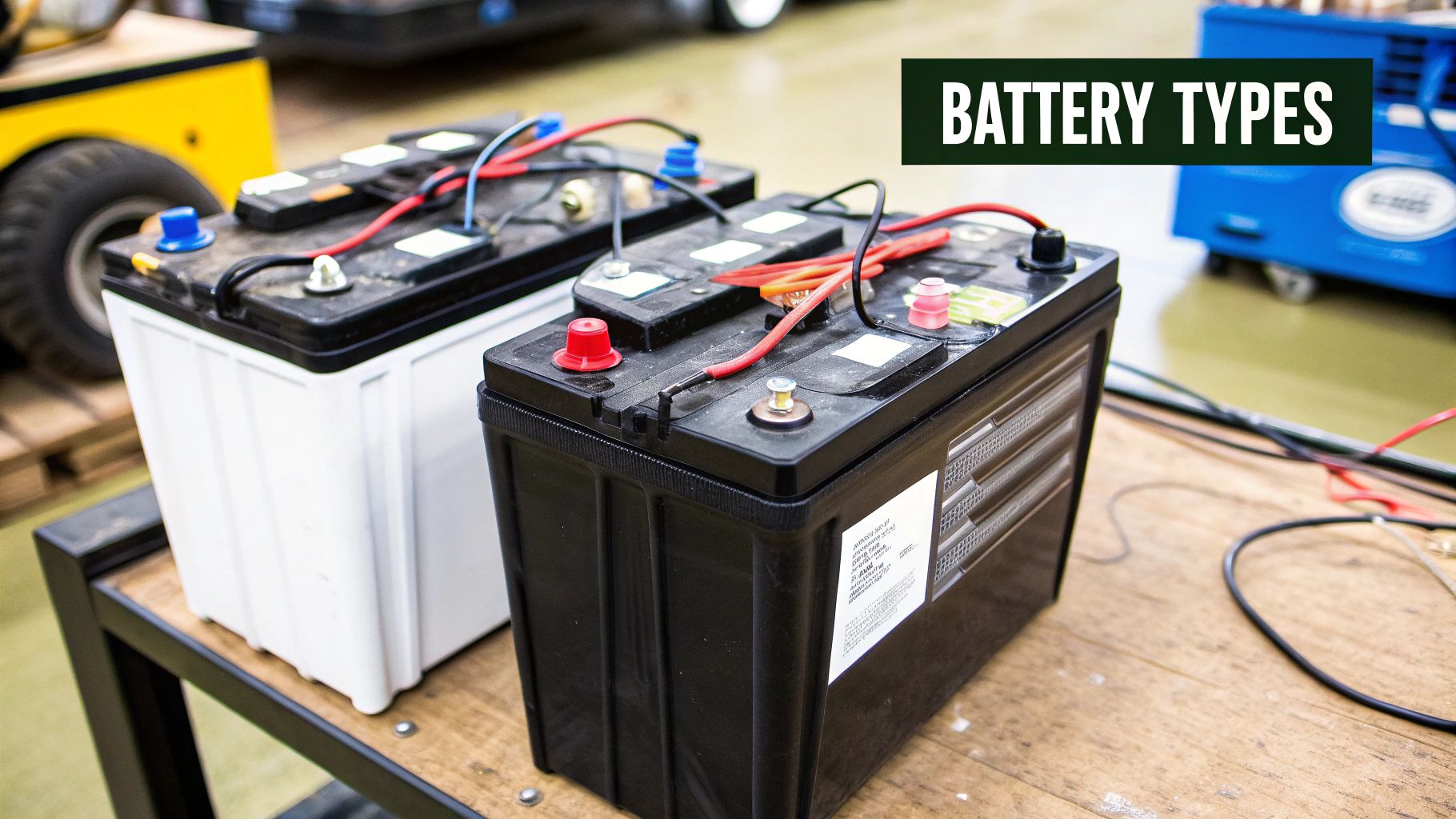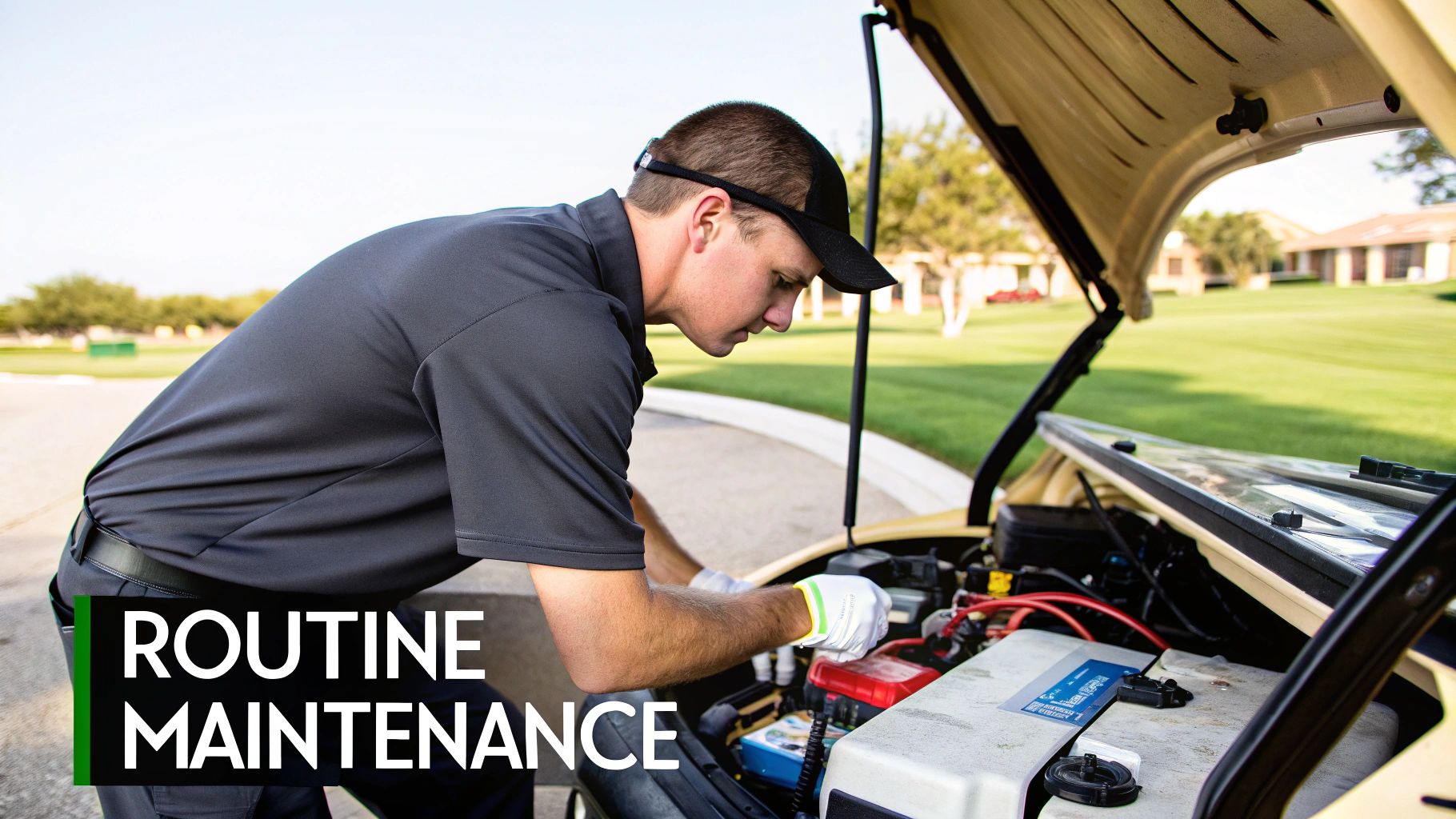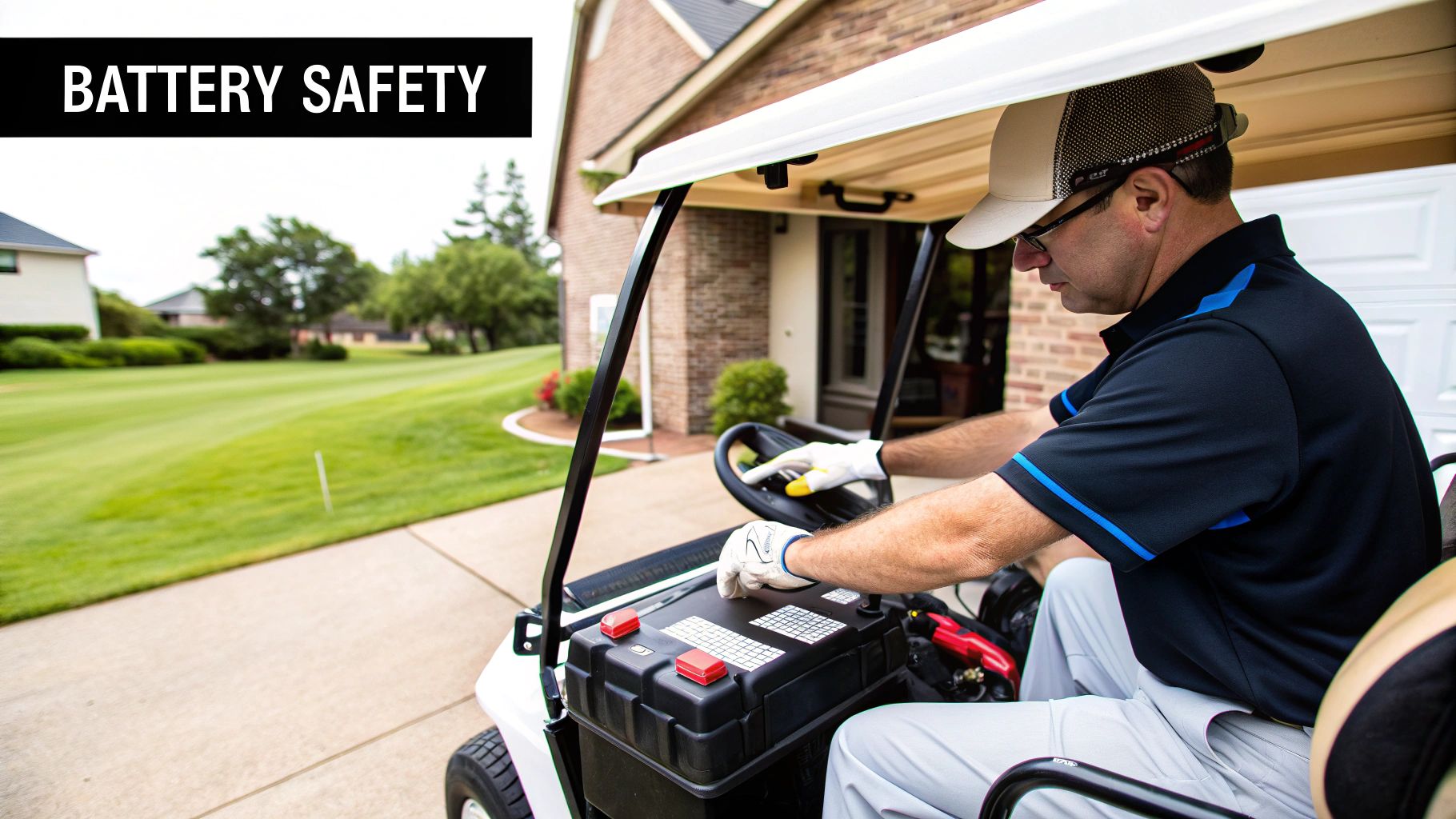When you hear people talk about golf cart power, they’re really talking about the tag team of the battery and the electric motor. It’s a simple but crucial partnership. Think of the battery as the fuel tank and the motor as the engine—together, they determine your cart's get-up-and-go, its muscle for climbing hills, and how far you can roam on a single charge.
What Really Drives Your Golf Cart
At its heart, your golf cart's performance comes down to this duo. The battery holds the electrical juice, and the motor turns that juice into the raw power that spins the wheels. This relationship dictates everything, from how fast you zip away from the tee box to whether you’ll conquer that steep fairway without chugging to a crawl. Getting a handle on this system is the first step to really understanding what your cart can do.
And this isn't some niche tech anymore—it’s the engine of a huge industry. The global golf cart market was recently valued between USD 1.72 billion and USD 1.95 billion. Experts predict it will blow past USD 3.35 billion by 2032. Electric models are completely taking over, expected to grab a whopping 95.3% of the market thanks to their clean, quiet efficiency. You can dig into more details on these market trends and what's fueling them.
Comparing Common Power Systems
The two workhorses in the electric golf cart world are the 36-volt (36V) and 48-volt (48V) systems. Generally speaking, a higher voltage means better efficiency and more torque—that’s the grunt your cart needs to tackle hills and carry a full load of passengers and gear.
A simple way to picture it: Voltage is the "strength" of your power system, while amp-hours (Ah) are its "stamina," or how long it can keep going.
This visual breaks down how these two popular battery systems stack up on things like range and how long they take to charge.

As you can see, the 48V system gives you a serious boost in range, though you'll need to plug it in for a bit longer. The right choice really comes down to what you value more: going the distance or getting back on the course faster.
The Battery: The Heart of Your Cart

If the motor is the engine, then the battery is absolutely the heart of your golf cart's power system. It’s easily the most critical component, dictating your range, overall performance, and even how you interact with your cart on a daily basis. When it comes to choosing, you're looking at two main technologies: old-school lead-acid and modern lithium-ion.
A good way to think about it is comparing a clunky old landline phone to the smartphone in your pocket. Sure, both can make a call, but the smartphone—much like a lithium battery—is lighter, lasts way longer on a charge, and packs more power into a smaller, sleeker package. This difference in golf cart power isn't just about convenience; it fundamentally changes how you use and maintain your cart.
Lead-Acid vs. Lithium: The Main Differences
For decades, lead-acid batteries were the undisputed king of the course. They’re heavy, require consistent maintenance like topping off water levels, and have a much shorter lifespan, typically giving you just a few hundred charge cycles. They get the job done and are cheaper upfront, but their weight and the need for regular upkeep are significant drawbacks for many owners.
Lithium-ion batteries, on the other hand, are a huge leap forward. They often weigh less than half as much, are completely maintenance-free, and can endure several thousand charge cycles. This means a single lithium battery can serve you well for a decade or more, making its higher initial price tag a smarter long-term investment for most people.
Key Takeaway: Your battery choice does more than just determine your range. It impacts your cart's weight, acceleration, maintenance schedule, and the total cost of ownership over its entire life.
The entire industry is moving toward more efficient electric options. It's not a small shift, either. By 2025, the electric segment is projected to grab over 95% of the market share. The global value is expected to grow from around USD 2.3 billion in 2025 to a massive USD 3.68 billion by 2035. You can discover more insights about these electric cart market trends to see just how quickly this technology is taking over.
Voltage and Amp-Hours Explained
Getting a handle on battery specs doesn’t need to feel like a physics lesson. Here’s a simple way to break down the two terms you'll see most often:
- Voltage (V): Think of this as the "strength" or raw power your cart has on tap. Higher voltage systems (like 48V) generally deliver better torque for climbing hills and snappier acceleration off the line.
- Amp-Hours (Ah): This is the battery's "stamina" or its total energy reserve. A battery with a higher Ah rating can supply power for a longer time, giving you more miles and more holes on a single charge.
No matter which type of battery you have, taking proper care of it is the best way to maximize its performance and lifespan. A few simple habits can make a world of difference. For some easy-to-follow tips, check out our guide on golf cart battery maintenance to keep your cart running strong all season.
Understanding Your Cart's Motor and Torque

While the battery is the fuel tank, your cart's electric motor is the engine. It’s the workhorse that takes all that stored electricity and turns it into the force that actually spins your wheels. Getting a handle on how your motor works is crucial if you want to understand your cart's real-world performance—and it goes way beyond just top speed.
The two big players here are torque and horsepower. The easiest way to think of them is like a tag team of athletes with totally different skill sets.
Imagine a weightlifter and a sprinter. The weightlifter has that explosive, raw strength to get a massive weight off the ground. That’s torque. The sprinter, however, is all about hitting top speed on a flat track. That’s horsepower. For a golf cart to be a great all-around performer, you really need a healthy dose of both.
Torque is the pure, twisting power that gets your cart moving from a dead stop and muscles it up steep hills. It’s the grunt work behind true golf cart power.
DC vs AC Motors
The type of motor humming away in your cart also makes a huge difference in how it drives. Most modern carts come with one of two types: Direct Current (DC) or Alternating Current (AC).
DC motors are the old-school standard. They’ve been around for ages because they’re fantastic at delivering low-end torque, which is perfect for getting a heavy cart moving. The downside? They can be less efficient at higher speeds and tend to generate more heat, which can sap performance over a long day.
AC motors are the newer tech on the block and are quickly becoming the go-to. They’re more efficient across the board, especially when you’re cruising at higher speeds, and they need less maintenance because there are no brushes to wear out. AC motors often feel smoother when you accelerate and can even offer regenerative braking, which cleverly sends a bit of juice back to the battery every time you slow down.
Why Torque Matters on the Course
Let’s be honest, for the everyday golfer, torque is usually far more important than a screaming top speed. Torque is what determines if your cart can handle the actual challenges you’ll face on a hilly, unpredictable golf course.
Think about these moments where high torque is your best friend:
- Climbing Steep Hills: A motor with plenty of torque will chug up a steep fairway without slowing to a pathetic crawl, even with two golfers and fully loaded bags.
- Starting on an Incline: Good torque is what stops that heart-in-your-throat rollback when you hit the pedal on a hill.
- Carrying Heavy Loads: If you’re hauling extra gear or have a couple of extra passengers, torque gives you the muscle to do it without straining the motor.
- Quick Acceleration: Whether you're pulling away from the tee box or navigating through a packed parking lot, torque delivers that snappy, responsive feel.
At the end of the day, a motor with solid torque just gives you a more capable and confident ride. It makes sure your golf cart power is ready and waiting when you need it most, turning potential struggles into effortless cruising. This is the force that lets you focus on your next shot, not on whether your cart has the guts to make it up the next hill.
How to Maximize Your Cart's Range and Lifespan
Just like a seasoned driver knows how to squeeze every last mile out of a tank of gas, you can learn the tricks to significantly extend your golf cart’s range and keep its battery healthy for years. Getting the most out of your golf cart power system isn’t about complicated mechanical wizardry; it’s about forming smart, simple habits that pay off over hundreds of rounds.
Think of your cart's battery like a muscle—it performs best with consistent, proper care but weakens quickly with neglect. One of the fastest ways to shorten its life is by running it completely dead time and time again. Instead, get into the habit of plugging it in after every use, even if you only played nine holes. This simple step prevents deep discharges that stress and degrade the cells, which is especially tough on traditional lead-acid batteries.
Using the right charger is just as crucial. A cheap, "one-size-fits-all" charger might seem like a bargain, but it can lead to undercharging or, worse, overcharging that cooks your battery and causes permanent damage. Always stick with the charger recommended by your cart or battery manufacturer to ensure a safe, efficient power-up every time.
Your Driving Habits and Course Conditions
It’s no surprise that how you drive has a direct, immediate impact on how far you’ll get on a single charge. Aggressive driving, with constant, jerky stops and starts, drains power far more quickly than smooth, steady acceleration. Every time you floor the pedal, you’re making a huge withdrawal from your battery’s energy bank.
The course itself plays a massive role, too. A flat, paved community path is a walk in the park for your cart compared to a soggy, hilly golf course.
- Hilly Terrain: Constantly climbing slopes demands a ton of power, draining your battery much faster than just cruising on level ground.
- Soft Ground: Driving on wet turf or sandy paths creates more rolling resistance, forcing the motor to work harder and chew through its charge.
- Added Weight: Every extra passenger, heavy cooler, or piece of gear adds to the workload, cutting down your potential range.
Maximizing range is all about minimizing resistance. A lighter load, smoother driving, and properly inflated tires all work together to help your cart travel farther on a single charge.
Even something as simple as tire pressure can make a noticeable difference. Underinflated tires create more friction with the ground, which is like driving with the brakes slightly engaged—a total waste of precious energy. A quick check with a pressure gauge before you head out can add valuable distance to your round.
To get a clearer picture, here's a quick breakdown of what impacts your cart's range the most.
Factors Affecting Golf Cart Range
Understanding these factors helps you plan your rounds better and avoid getting stranded on the back nine.
| Factor | Impact Level (Low/Medium/High) | How to Mitigate |
|---|---|---|
| Terrain (Hills vs. Flats) | High | Plan routes to avoid steep climbs when possible; maintain steady momentum. |
| Vehicle Weight (Load) | High | Pack only what you need; avoid carrying unnecessary gear or passengers. |
| Driving Style | Medium | Accelerate smoothly and avoid sudden stops. Maintain a consistent speed. |
| Tire Pressure | Medium | Check and inflate tires to the manufacturer's recommended PSI regularly. |
| Battery Age & Health | High | Follow proper charging protocols; replace old or failing batteries. |
| Course Conditions (Wet/Dry) | Medium | Be mindful that soft, wet ground will use more energy than dry, firm turf. |
By knowing how these elements affect your cart, you can better predict and manage your battery usage. Getting a handle on these variables is key to truly understanding how long golf cart batteries last in real-world conditions.
When you combine smart charging routines with mindful driving and a bit of basic upkeep, you’ll ensure your golf cart delivers the reliable performance you need to stay on the course and in the game for years to come.
Choosing the Right Power System for Your Needs

Alright, now that you’ve got the technical parts down, let’s connect those details to what really matters: how you actually use your golf cart. The best golf cart power system isn’t about shelling out for the most expensive components. It’s about getting the right ones for your lifestyle.
Think about it like buying a car. You wouldn't get a giant pickup truck for a tight city commute, and you wouldn't try to haul lumber in a two-seater sports car. The same logic applies here. The needs of a casual weekend golfer are worlds apart from someone who uses their cart as their main ride in a sprawling community.
Matching Power to Your Persona
To make it easier, let's break down a few common types of cart owners and what they should be looking for. See if one of these sounds like you.
-
The Weekend Golfer: Your cart’s main job is getting you through 18 holes on a Saturday. Your biggest priorities are reliability and having just enough juice to finish the round without getting range anxiety on the back nine. A solid lead-acid battery system (go for 48V if your course has hills) or even a smaller, budget-friendly lithium pack is a fantastic fit. You don't need to cross the county, just the course.
-
The Community Cruiser: Your golf cart is basically your second car. It gets you to the pool, to your neighbors' houses, and on quick errands around the neighborhood. For you, range and pure convenience are everything. A high-capacity lithium battery is your best bet, hands down. It gives you maintenance-free operation and lets you travel for miles and miles on a single charge. No more plugging it in after every little trip.
-
The Golf Course Fleet Manager: You’re running a business, so it’s all a numbers game. You need carts that can take a beating, are simple for anyone to operate, and won't drain your maintenance budget. While the lower up-front cost of lead-acid batteries is tempting for a big fleet, the longer lifespan and zero-maintenance reality of lithium are making more and more sense. Your decision really comes down to balancing that initial investment against long-term operational costs and cart downtime.
By figuring out your primary use case first, you can immediately cut through the marketing noise and focus on the specs that will actually make a difference for you.
Ultimately, you’re looking for that sweet spot where performance, cost, and convenience meet your day-to-day reality. If you want a bit more guidance, our electric power cart guide for choosing smart transportation has even more tips to help you feel confident in your choice. When you match your golf cart power system to your personal needs, you end up with a vehicle that feels like it was built just for you.
Frequently Asked-Questions About Golf Cart Power
Even after you get a handle on the basics of batteries and motors, some practical questions always seem to pop up. Let's tackle some of the most common things people ask about upgrading, troubleshooting, and understanding the real costs of keeping their golf cart running strong.
Can I Upgrade My 36V Cart to 48V?
You absolutely can, and it's one of the most popular upgrades for a reason. Bumping up a 36-volt system to 48 volts gives you a serious boost in torque and overall efficiency. Hills that used to slow you to a crawl suddenly feel much easier.
But—and this is a big but—it's not as simple as just dropping in new batteries. To do it right and keep things safe, a full conversion means you'll also need to replace the motor, controller, solenoid, and all the heavy-duty wiring. The entire system has to be able to handle that extra juice.
A 36V to 48V conversion is a real investment, but the payoff is huge. You get a noticeable improvement in hill-climbing power and a much snappier, responsive feel that completely changes how your cart performs on the course.
Why Is My Fully Charged Cart So Slow?
This one is frustrating. You see the meter says "full," but the cart just doesn't have its usual get-up-and-go. The problem often goes deeper than just the charge level. A few usual suspects are to blame:
- Aging Batteries: As lead-acid batteries get older, they lose their punch. They might still show a full voltage reading right off the charger, but they can't deliver the consistent power needed to maintain speed, especially under load.
- Controller Problems: Think of the controller as your cart's brain. If it starts to fail, it can't properly regulate the power going to the motor, leaving you with sluggish performance no matter how charged the batteries are.
- Brake Drag: This is a sneaky one. Sometimes the brakes don't fully release after you let off the pedal. This creates constant resistance, forcing the motor to work overtime just to move, which kills your speed and drains your battery fast.
- Low Tire Pressure: It sounds too simple, but it’s a common culprit. Seriously underinflated tires create a ton of rolling resistance, making your motor work way harder than it should.
Always start with the easy stuff. Check your tire pressure and make sure the cart rolls freely without any brake drag. If those check out, it might be time to get your batteries and controller looked at by a pro. A little bit of preventative care goes a long way.
Ready to stop pushing and start driving? The Caddie Wheel delivers robust, remote-controlled power to your existing push cart, letting you walk 36 holes with ease. Learn more and upgrade your game at caddiewheel.com.


Share:
Top Golf Bag Electric Cart Picks for Better Golfing
Your Guide to a Golf Push Cart Electric Conversion Kit